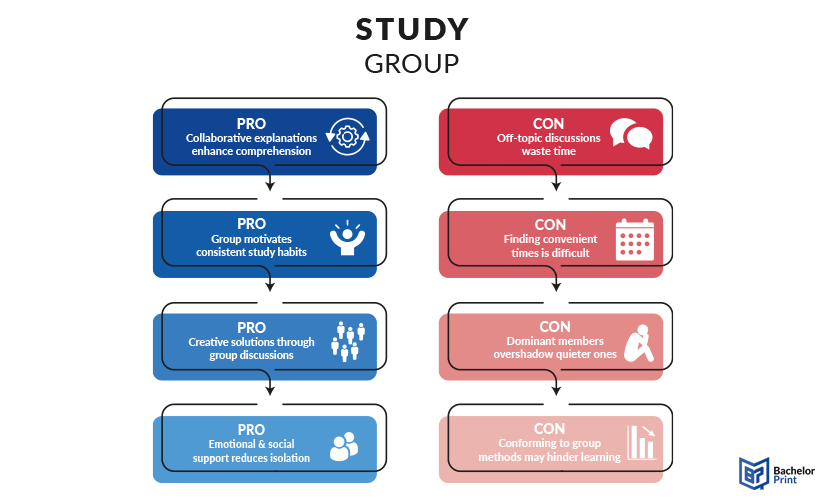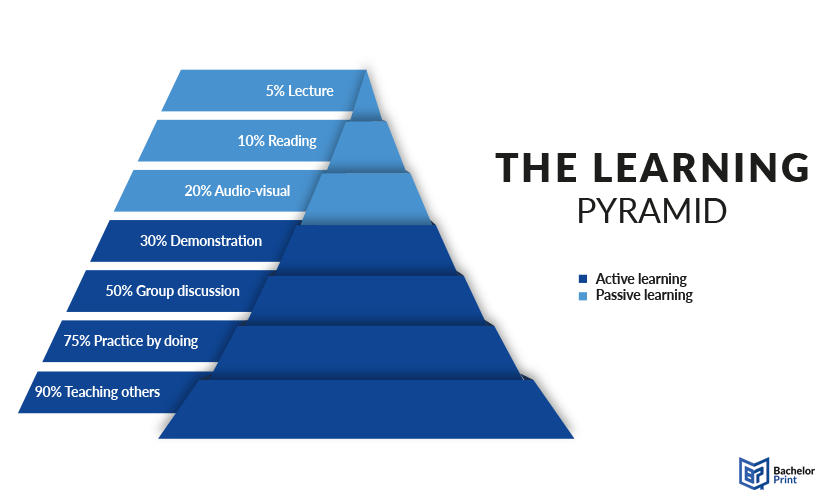
In the fast-paced world of education, the traditional approach of solitary study is giving way to the dynamic and collaborative method of study groups. A collective of individuals who come together to explore, discuss, and master academic content, has proven to be a powerful tool in enhancing the learning experience. This article delves into the intricacies of study groups, highlighting their methodology and the benefits they offer to participants.
Definition: Study group
A study group is a collaborative learning arrangement where a small number of individuals come together regularly to study, discuss, and deepen their understanding of specific academic subjects or topics. The primary objective of a study group is to enhance each member’s comprehension and retention of the material through collective effort and shared knowledge.
Types of study groups
When it comes to study groups, there are three broad types: the study team, working team, and learning team. Here’s a breakdown of these types.
Study team
The study team focuses primarily on academic content and subject mastery by studying and learning as a collective. The activities often include reviewing course material, discussing difficult concepts, and preparing for exams together. The study team can be both formal or informal, with personal or online meetings at scheduled intervals and a shared goal of improving understanding and performance in a particular subject.
Working team
The working team focuses on completing collaborative projects and assignments. In this team, members divide tasks, work on different parts of a project, and integrate their contributions to complete group assignments. This type of study group typically has a defined timeline and roles, with a clear objective related to completing a specific project or piece of work.
Learning team
The learning team is a more general type of study group with a broader focus on educational and personal development. It combines elements of both study and working teams by engaging in discussions, sharing resources, and exploring topics beyond the curriculum. They might also work on developing skills such as critical thinking, communication, and teamwork. Meetings can be regular or as needed, based on members’ interests and learning goals.
How to run a successful study group
Running an effective study group requires careful planning, clear communication, and active participation from all members. Here’s a step-by-step guide to help you organise and manage a successful study group.







1. Forming the group
Look around your classroom and choose individuals with similar academic goals and ask them if they would be interested in regularly meeting. You should pay attention to their level of effort in the classroom to determine if they would be an active member. You could also ask your teacher to make an announcement about your group at the start of class to ensure more people will join. However, the study group should be a manageable size of no more than six members.
2. Discuss guidelines
Clear goals should be established for each meeting, such as exam preparation or understanding specific topics. Are the meetings supposed to be in-person, online, or a mix of both? How will the study group deal with conflict, particularly when members are not pulling their weight? Some experts in cooperative learning even suggest creating documents outlining group policies and expectations.
3. Assign specific roles
To ensure that every group member actively participates, and one person is not doing all the work, it is important to assign some members specific roles. Such as setting times and location, setting weekly agendas, creating practice questions, changing group leaders each week, or teaching other group members about a difficult concept so that everyone is on the same level. Teaching others is also beneficial for members with more expertise since this will lead to more profound learning and longer-term retention.
4. Choosing the venue
If you are not meeting online, many municipal and university libraries have study rooms that can be reserved. Make sure to reserve an area where the group will not disturb others and can talk freely. The space should be big enough for everyone to spread out their materials. If there are no study rooms available, look for other locations such as group members’ homes or quiet coffee shops. Healthy snacks and drinks such as fruits, nuts, hummus, or veggies should be available as well to help everyone focus instead of feeling full and tired.
5. Conduct meetings
Now that everyone has a specific role, each meeting should begin with a quick review of what was covered in the previous session and addressing any uncertainties before moving on to new material. At the end of each study session, everyone should have a clearer idea of what they know and don’t know. This can be achieved by feedback made by other group members during group discussion or quizzes. You can set up a chat group where everyone will be able to communicate outside the study sessions as well and be informed on sudden changes.
6. Take breaks
If study sessions are longer than 45 minutes, it is important to timetable in breaks for stretching, using the public toilet, checking your phone, or other things. Everyone’s study habits should be incorporated since some people prefer working longer sessions and taking longer breaks, and some prefer working shorter sessions with quick breaks. Generally, study sessions should be about one to two hours long. Refer to our article about study timetables that explains the pomodoro study technique.
7. Enhancing group dynamics
Everyone should ensure that the study environment maintains supportive and respectful. Members should feel comfortable sharing ideas, asking questions, and providing constructive feedback to build confidence and motivation. Disagreements should be addressed promptly and diplomatically. By integrating metacognition into the group’s dynamics, members can become more aware of their own learning process and develop strategies to improve their retention of the material.
How to participate in a study group
If you would rather not host a group for studying, there are many websites online that focus on virtual study groups with students from different universities or countries. Some universities even offer a study group programme for their students. Online study allows you more flexibility to maintain your study-life balance and pursue part-time jobs because you can specifically look for groups with fellow night owls or early birds.
Studying with peers from different areas can even expose you to diverse perspectives and approaches to learning, which can enrich your understanding of the material. Some online platforms offer groups led by subject-matter experts or tutors who provide professional guidance and support.
Pros and cons of a study group
Even though collaborative learning arrangements can mutually benefit each student, sometimes problems can arise due to different personalities clashing together. Below, we have listed possible benefits and difficulties of study groups.
Benefits
Some benefits of collaborative studying are listed below.
- Enhancing understanding: Collaborative learning has been proven to deepen understanding as members explain concepts to each other. Different perspectives can lead to a more comprehensive grasp of the study material.
- Increased accountability: Group members motivate each other to stay on track and maintain a regular study timetable. When you study on your own, the temptation to procrastinate is incomparably larger than when in an interactive environment.
- Improved problem-solving skills: Working through issues as a group can lead to creative solutions and a more profound understanding of complex issues. Healthy debates are especially helpful for students since this involves defending your ideas and finding solutions.
- Emotional and social support: Study groups provide a supportive environment where members can share concerns and stress that come with university or personal issues. Social interaction can heavily reduce feelings of isolation, especially in demanding academic programs.
Problems
Below are common issues that can arise.
- Distractions and off-topic discussions: Group meeting can sometimes veer off-topic, which leads to wasted time and a lack of concentration when it comes to the primary focus of studying.
- Scheduling conflicts: Coordinating meeting times that work for all members can be challenging. Conflicting schedules may lead to irregular meetings or reduced attendance.
- Unequal participation: Dominant personalities might overshadow quieter members, which reduces their opportunity to participate. This can lead to an imbalance in workload and benefits.
- Peer pressure: Pressure to conform to the group’s study methods and pace may not suit everyone’s learning style. Some members might feel compelled to attend weekly meetings even when it is unproductive for them.
Here’s an image that combines all benefits and problems of a study group.

The Learning Pyramid
The Learning Pyramid, also known as the Cone of Learning or Pyramid of Learning, is a model that illustrates the varying degrees of retention associated with different teaching and learning methods. The pyramid was developed by the National Training Laboratory and suggests that certain methods lead to better retention and understanding than others. Here’s an image of the Learning Pyramid, from most effective at the bottom to least effective at the top.

Lecture is a passive form of learning and is one of the most ineffective methods for retaining information, as it involves passive listening without active engagement. However, this method might be more stimulating for auditory learners.
Slightly more effective for retention is reading, which is required in most academic settings. While visual learners find this method of learning more effective, students with a non-visual learning style do not.
According to the Learning Pyramid, an audiovisual learning method leads to a 20% retention and includes videos, sounds, images, and graphs. This method combines both visual and auditory learning, making it more effective than the previous two methods.
Demonstration typically involves observing a practical example of a concept or a skill. This is one of the first study methods that slightly taps into the active learning method as learners primarily watch. However, learners can ask questions and engage with the presenter and real-world applications additionally help them understand how to apply the concepts themselves.
A group discussion is a form of cooperative learning by actively participating in discussions where everyone shares ideas and engage in conversations about the material. This encourages engagement and critical thinking, leading to better retention of information.
Practice by doing is one of the most effective methods of learning and studying as students engage in hands-on activities or practical exercises related to the material. This allows learners to apply concepts and skills in real-life scenarios, significantly improving retention and understanding by moving information from short-term to long-term memory.
Teaching the material to someone else is the most effective method for retaining information, as it requires a more profound understanding of the material to explain it clearly to others. This process reinforces learning and solidifies knowledge, which illustrates another benefit of joining a study group.
FAQs
A study group is a small group of students that collectively study, discuss, and deepen their knowledge about certain subjects and topics.
Some disadvantages of a study group are listed as follows:
- Distractions due to off-topic discussions
- Difficulty with finding mutually convenient times to study
- Unbalanced participation due to dominant students
- Conforming to a different learning style may hinder learning
You can either ask your fellow classmates with similar academic goals to regularly meet and study together, or you can join an already existing study group online.
A study group is very effective because it involves active learning methods, such as group discussions and teaching others. Additionally, it exposes you to different ways of thinking and learning and provides support and motivation to study and show your own study skills.
For initial stages, we advise studying on your own, while for later stages, group studying in a study group is more effective. A combination of both is ideal for improving your retention and recall of information.
